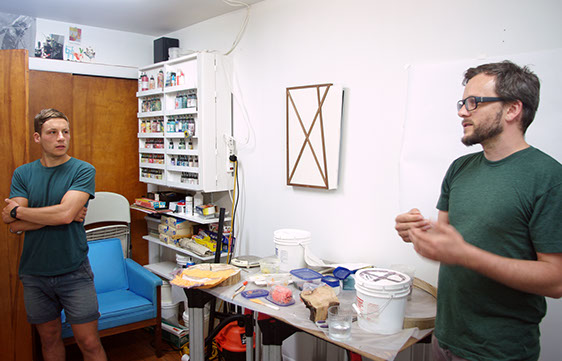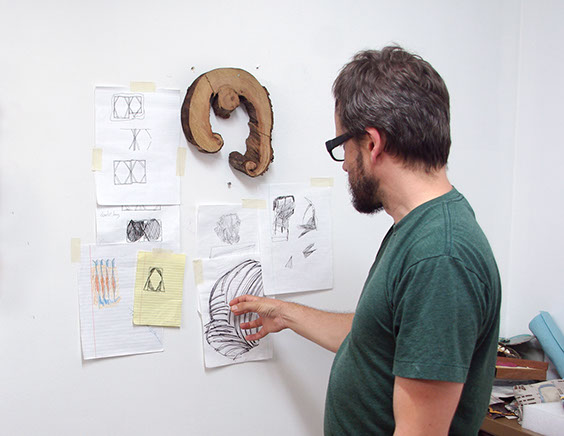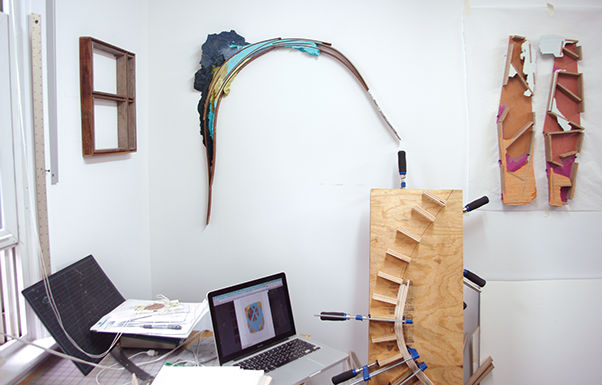





3 - 5
<
>
Interview Pt. 1 of 2:
Will Hutnick with Christian Maychack
Will Hutnick: I think it is interesting that we both come from a background in printmaking, and share similar concerns about the rigidness and strictness, so to speak, of traditional printmaking; either the frustration with process(es), techniques, not making editions precise/correct, etc. Can you talk about how you initially became interested and involved with printmaking? What underlying goals and issues that you were experimenting with then are re-investigated and addressed with your current body of work?
Christian Maychack: Looking at it now, I think that I was initially drawn to the sense of control and order that the process of printmaking lends itself to. I had just started taking art classes in my fourth year in college and was simultaneously drawn to and terrified by abstraction. I think I used the rigor of the printmaking process as a sort of tether to the world. I could justify abstraction to myself by losing myself in the order of things.
I still see the processes that I have developed for myself acting in a similar way, but more interwoven. I’m always searching for ways of reworking that balance.
Will Hutnick (left) speaks with Christian Maychack (right) during studio visit
Photo: Scott Robinson

WH: Why do you think you were terrified by abstraction? Do you feel like your current practice "justifies abstraction" in a similar way that printmaking did for you?
CM: I wouldn’t say that I still need to justify abstraction like I did then. Art, let alone abstraction, was very new to me at the time. I was studying to be a math teacher, and felt comfortable with that kind of logic. Abstraction seemed too far beyond language to me at the time, but I was committed to understanding it and making it my own.
WH: A fellow math nerd! Yesss.
Let's talk about your initial interest in abstraction. What were the kinds of images you were originally making? Representational? Are there any specifics artists that you were initially drawn to?
CM: So, pretty soon after discovering art, while I was still an education major, I took a 2-D design class. The instructor, Ken Dunlap, would not allow us to make work that represented anything from the world or that even accidentally looked like a thing. He was pretty strict about it. This was my introduction to non-objective abstraction and I fought it the entire time. It felt so arbitrary and out of control. It really scared the shit out of me, but when the class ended I started obsessively painting grids of abstract, biomorphic shapes in my spare time, not showing them to anyone. I was really trying to make sense out of it and impose some order.
Once I did start showing them to my professors, they all started pointing me to all of the AbEx artists. There wasn’t much of anything contemporary that I remember from that library. I was all over the place, but spent a lot of time with Motherwell, Frankenthaler, and Diebenkorn books. Diebenkorn was the one I was most obsessed with. I can see now that it was because he showed so much of his process and exercised so much control. That appealed to me. I actually moved to the Bay Area in 1998 because I wanted to be where he was so influenced by the light and landscape.
WH: Is that where you did your undergrad, in CA?
CM: No, I got my undergraduate degree at Ohio University and my graduate degree at San Francisco State University.
WH: Do you think being in San Francisco played a major role in the work you were creating at the time?
CM: Yes, it played a part for sure, but it took awhile for that place to really sink in. Within a couple of years of moving to SF I made a complete switch to sculpture. At that time I really started responding to a lot of the architecture in the Bay Area, and also a lot of the quirkiness started working its way into my work. It became more playful, almost silly at times.
WH: A lot of the quirkiness in the surrounding architecture?
CM: My time there really got me thinking about my built environment and I think that had a lot to do with thinking about potential earthquakes and the insecurity of surrounding structures.

Christian Maychack during studio visit
Photo: Scott Robinson
WH: I'm curious about your transition to sculpture. To go back to Diebenkorn for a second, you mention his reveal of his process throughout his work as well as his control; I'd like to discuss that more especially in relation to your work, which seems to be based upon setting up parameters and structures and letting a fair amount of chance and discovery take over.
CM: So, I was a pretty extreme believer in a lot of the dogma of the Abstract Expressionists. I had seen pictures of, and read many more descriptions of paintings that I loved than I had ever seen in person. I think that when I started to see more paintings in the flesh, over time I was less and less able to feel as if I could 'enter' the picture plane. So I started focusing on the edges too much, and stopped caring about the fronts of the paintings.
During this time, my paintings started to become smaller and chunky and I would carve into the 3/4" thick plywood panels, leaving bits of the wood showing, filling parts with cement. After those paintings I left for sculpture all together.
WH: It's funny to hear yourself describe your work as leaving painting behind, although you are still very much operating in the realm of painting, playing with pigments and color and form, especially with your relationship to the grid and stretcher bars that become prominent features in your work.
CM: Well, I lost interest in painting in 2000, and didn't return to an interest in painting until 2010. I never thought that I would return.
WH: Have you ever created installations before? Is that something you’ve ever thought about, your work having a physical environment to live in? Your work has this quality where yes, it is literally contained by wooden structures and supports, but also feels like it could bust out at any minute, exploding in real time and in our space.
CM: After graduate school, a lot of the work that I was doing was site-specific installation. They were anthropomorphic structures that seemed to grow out of the architecture. I was pretty interested how a viewer relates to their physical environment and I think that those elements carry through to my newer work.
WH: Last question: who are some artists that you are attracted to and inspired by right now? Any particular exhibitions that have blown you away?
CM: Oh man, that's a hard ass question. I'm really bad at paying attention to the art world.
WH: I think that’s a perfect answer.
Christian Maychack is represented by Jeff Bailey Gallery in New York City and by Gregory Lind Gallery in San Francisco
He lives and works in Brooklyn
Will Hutnick is the featured artist on Paintingisdead.com for the month of August.

Studio of Christian Maychack
Photo: Scott Robinson
Interview Pt. 2 of 2:
Scott Robinson with Christian Maychack
Disclaimer: All views and opinions expressed are those of the authors and do not necessarily reflect the views of the editors, owner, advertisers, other writers or anyone else associated with PAINTING IS DEAD.